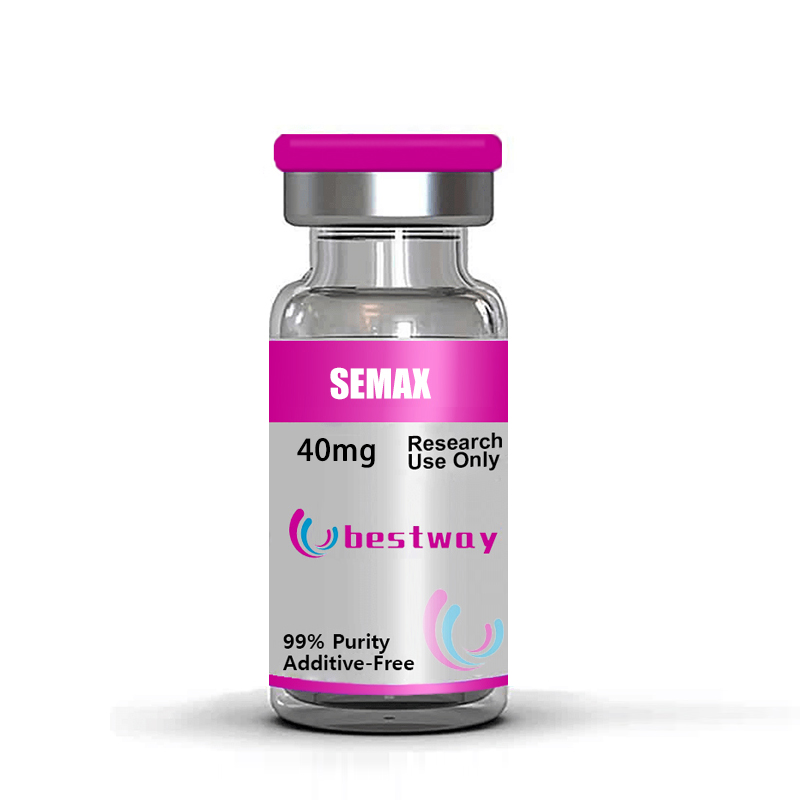Class of Compound:
Peptide
Mechanism of Action:
Semax is known to stimulate neurotrophic factors in the central nervous system, namely Brain-Derived Neurotrophic Factor (BDNF) and Nerve Growth Factor (NGF). It further appears to impact serotonin, dopamine, and enkephalin signaling.
Notable Studies:
· Semax in the treatment of glaucomatous optic neuropathy in patients with normalized ophthalmic tone
· The efficacy of semax in the treatment of patients at different stages of ischemic stroke
· Synthetic ACTH analog Semax displays nootropic‐like activity in humans
What is Semax?
Semax is a synthetic peptide that was first developed by Russian researchers in the 1980s. It is authorized in Russia and Ukraine for indications including ischemic brain stroke, encephalopathy, optic nerve atrophy, and cognitive disorders such as dementia.
Research suggests that Semax may offer potential benefits to patients suffering from a variety of neurological conditions, including Alzheimer's, traumatic brain injury (TBI), and stroke.
Semax is an analog of the ACTH(4-10) peptide, the latter a fragment of adrenocorticotropic hormone (ACTH). ACTH is a hormone that plays a key role in cortisol production in the body.
Structurally, Semax is made of seven amino acids, including a four amino acid fragment (Met-Glu-His-Phe) from ACTH (4-7) and a Pro-Gly-Pro fragment attached at the C-terminus. This structure allows the peptide to cross the blood-brain barrier.
Modern researchers report that Semax can reach significant concentrations in central nervous tissues and exert its purported benefits on the brain, such as neuroprotection and enhanced cognitive performance.
Semax is also frequently modified via acetylation and amidation, leading to the formation of N-Acetyl Semax Amidate. This alteration may modulate its interaction with substances like copper ions and redox agents, possibly enhancing its stability in the process .
Before purchasing Semax for research purposes, it is critical to understand this peptide’s side effects, risks, dosing guidelines, and legal status.
Our team of researchers covers all of these considerations below before providing our top recommendations for where to buy Semax online as a reference material.
How Does Semax Work?
Semax is a research peptide that is designed to cross the blood-brain barrier (BBB) while avoiding the hormonal effects of ACTH. Instead, Semax may improve overall brain health and enhance cognitive performance via the following mechanisms:
· Interacting with dopamine, serotonin, and enkephalin signaling, and
· Elevating Brain-Derived Neurotrophic Factor (BDNF) and Nerve Growth Factor (NGF) levels in the brain for enhanced neurogenesis and neuroregeneration .
Researchers report that Semax may exert its neuroprotective benefits by upregulating both BDNF levels and the corresponding tropomyosin-related kinase B (trkB, aka tropomyosin receptor kinase B) receptors found in brain cells.
BDNF is a neurotrophic growth factor that is key to brain cell survival and neuroplasticity. Semax appears to upregulate BDNF levels 1.4-fold and the trkB receptor expression 2-fold.
Further, studies reveal that the peptide may interact with serotonin and dopamine signaling in the brain, although the potential effect of these interactions is not well-studied. Some studies also report an upregulating effect of Semax on enkephalins—the physiological ligands of opioid receptors.
Interacting with these neuromodulators in the brain may have effects on mood, stress, cognition, and reward-related behavior. However, researchers are yet to investigate whether Semax has any related benefits. So far, only test animal experiments report potential protective effects of Semax against anxiogenic substances.
Semax may also provide benefits outside the nervous system, such as regulating blood flow, microcirculation, and vascular permeability in the gastrointestinal system. As a result, the peptide may have anti-ulcer effects, but more research is required to confirm these benefits.
Semax Benefits
Researchers are actively investigating the potential effects of Semax on the brain and other organs. Preliminary research suggests that potential benefits of Semax include:
· Cognitive enhancement
· Mood regulation
· Neuroprotective properties
· Gastroprotection
Below, we will take a closer look at each of these potential benefits.
Semax for Cognitive Enhancement
The available clinical data suggest that there is a potential effect of Semax on cognition. One study examined the impact of intranasal Semax on the cognitive functions of healthy but fatigued study volunteers who had completed 8-hour work shifts.
Following a single intranasal administration of the peptide at a dosage of 16mcg/kg of body weight, the effects lasted for 24 hours. According to the researchers' findings, participants who received Semax demonstrated a 71% accuracy rate on a memory test, in stark contrast to the average 41% rate observed in the control group .
Another trial investigated the impact of Semax on the default mode network (DMN) of the brain in 24 middle-aged individuals using fMRI. DMN is associated with the evaluation and processing of emotions, episodic memory, and capacity for social interactions. The participants received either a 1% Semax solution or placebo via intranasal application, and fMRI scans were conducted before administration, as well as 5 and 20 minutes afterward.
The results indicated that the Semax group exhibited increased volume in the rostral subcomponent of the DMN, specifically within the medial frontal cortex, compared to the control group. Semax was thus speculated to provide potential benefits for associated functions such as information processing and episodic memory.
Semax for Mood Regulation
Currently, the evidence on the potential of Semax for mood regulation in conditions such as anxiety and depression is scarce.
An animal study explored the effects of intranasal Semax (50 and 500mcg/kg) on anxiety and depression in rats, both in their normal state and under stress induced by CCK-4 (cholecystokinin-tetrapeptide)—an anxiogenic substance commonly used to simulate anxiety disorders.
While Semax had no effect on rats in their normal state, it was able to normalize disrupted behavior caused by CCK-4, suggesting potential anxiolytic and antidepressant effects when anxiety and depression levels are elevated.
Semax for Neuroprotection
Semax has been studied primarily for its potential neuroprotective effects. Several preclinical and clinical trials support the peptide's benefits for various neurodegenerative and neuroinflammatory conditions, including stroke.
For example, in a trial involving 110 stroke patients, intranasal administration of Semax in two 10-day courses of 6000mcg/day showed increased plasma BDNF levels. This led to improved motor performance and enhanced functional independence as assessed by Barthel index scores—an index for assessing functional independence in stroke patients.
Another trial conducted on patients with acute stroke patients also demonstrated significant anti-inflammatory benefits of Semax. The study indicated that Semax contributed to an increased prevalence of anti-inflammatory mediators (such as interleukin-10 and tumor necrosis factor-alpha) while reducing proinflammatory factors (such as interleukin-8 and C-reactive protein).
In a smaller study involving 30 patients with chronic brain ischemia, a condition often associated with dementia, Semax was administered in conjunction with adenosine diphosphate (ADP) and collagen. The treatment group exhibited better recovery outcomes than the control group. The study authors reported that the peptide improved the patients' conditions by exerting both neurotrophic and anti-platelet effects.
Clinical trials also report that intranasal Semax has been shown to protect against pressure-induced nerve damage in glaucoma patients.
Further, the peptide may provide benefits versus various neurotoxins. For example, one clinical trial suggests that the peptide protects against the neurotoxic effect of alcohol intoxication.
Pre-clinical trials have also reported protective effects of Semax in a rat model of Parkinson's induced by the neurotoxin MPTP (1-methyl-4-phenyl-1,2,3,6-tetrahydropyridine) .
Semax for Gastroprotection
According to Ivanikov et al. (2002), Semax has potential gastroprotective and anti-ulcer effects. The study showed that intranasal administration of a 1% Semax solution was nearly three times more effective than placebo in promoting the healing of peptic ulcers.
Participants in the treatment group received 2-4 drops of Semax in each nostril three times daily for 10 days, and experienced a healing rate of approximately 90%, compared to just over 30% in the placebo group.
As mentioned, the researchers postulated that these positive outcomes may be attributed to an unexplored influence of Semax on the regulation of blood flow, microcirculation, and vascular permeability. However, more research is needed to confirm these mechanisms .
Semax is a synthetic analogue of the adrenocorticotropic hormone, a hormone responsible for the production of cortisol which in turn regulates glucose and lipid metabolism and helps to maintain blood pressure. In the hippocampus, Semax rapidly elevates the levels of brain-derived neurotrophic factor (BDNF), a protein important in encouraging growth and differentiation of new neurons and synapses. BDNF is active in the hippocampus, cortex, and forebrain and is important for memory, coordination, concentration, and learning. Semax also works to activate the dopaminergic and serotonergic systems to help prime the brain for action and to induce a controlled state of mental stress.















